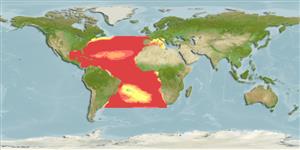Classification / Names
Common names from other countries
Main reference
Size / Weight / Age
Max length : 300 cm TL male/unsexed; (Ref. 4770); common length : 210 cm TL male/unsexed; (Ref. 5217); max. published weight: 82.5 kg (Ref. 43)
Length at first maturity
Lm 164.0, range 130 - ? cm
Environment
Marine; pelagic-oceanic; oceanodromous (Ref. 51243); depth range 0 - 150 m (Ref. 43), usually 0 - 100 m (Ref. 55219)
Climate / Range
Subtropical; 22°C - ? (Ref. 12451), preferred 27°C (Ref. 107945); 47°N - 39°S, 99°W - 20°E (Ref. 55219)
Distribution
Atlantic Ocean: roughly from 45°N to 45°S in the southwestern Atlantic and 35°S in the southeastern Atlantic. Records from the Mediterranean Sea, and from Bretagne, France seem to correspond to a few straying individuals. Classified as 'reduced' (Ref. 12451). It is unclear whether there are two separate stocks or a single population in the Atlantic. Highly migratory species, Annex I of the 1982 Convention on the Law of the Sea (Ref. 26139).
Countries | FAO areas | Ecosystems | Occurrences | Introductions
Short description
Dorsal
spines
(total): 0;
Dorsal
soft rays
(total): 43-52;
Anal
spines: 0;
Anal
soft rays: 17 - 23. Blue-black above, silvery white and splattered with brown on the sides, silvery white below; sometimes with more than 15 rows of obscure whitish stripes; 1st dorsal fin dark blue with black dots; 2nd dorsal fin dark blue; pectorals blackish brown, with tinges of silvery white in some specimens; pelvic fins blue-black with a black fin membrane; caudal fin blackish brown.
IUCN Red List Status (Ref. 115185)
Threat to humans
Harmless
Human uses
Fisheries: minor commercial; gamefish: yes
More information
ReferencesAquacultureAquaculture profileStrainsGeneticsAllele frequenciesHeritabilityDiseasesProcessingMass conversion
Tools
Special reports
Download XML
Internet sources
Estimates of some properties based on models
Phylogenetic diversity index
PD50 = 0.7505 many relatives (e.g. carps) 0.5 - 2.0 few relatives (e.g. lungfishes)
Trophic Level
4.5 ±0.4 se; Based on diet studies.
Resilience
Medium, minimum population doubling time 1.4 - 4.4 years (K=0.58; assuming tm >=2)
Vulnerability
Moderate vulnerability (41 of 100)
Price category
